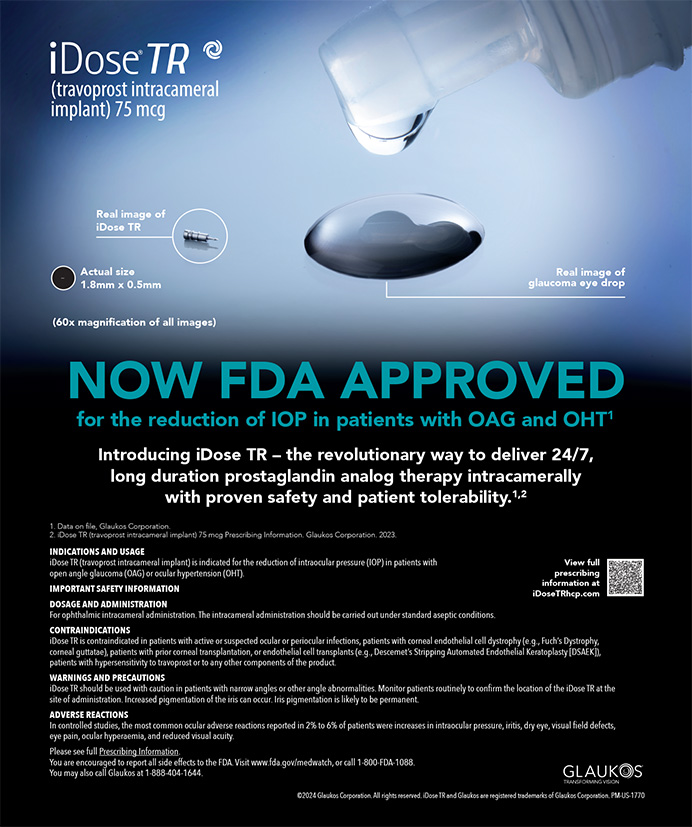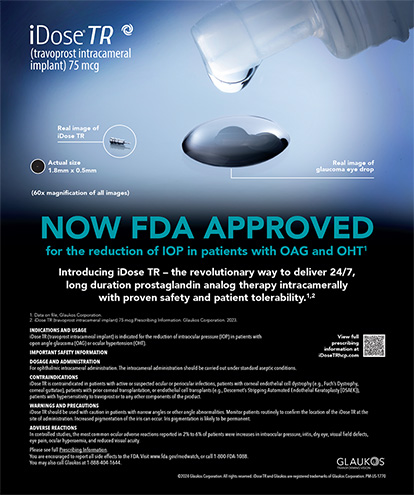Since I began using the Bausch & Lomb Technolas 217z excimer laser (Bausch & Lomb, Inc., Rochester, NY) 2 years ago, my personal retreatment rate has decreased to 2.3% from 10.8%. Among the noticeable benefits, the new Zyoptix 100 laser system (not approved for sale in the US) should improve safety, efficiency, and outcomes in customized treatments. This article reviews the new system's features, including a 100-Hz laser source, Iris Recognition software, three-dimensional eye tracking, and greater treatment capabilities.
THE LASER PLATFORMPreionization
The Zyoptix system (Figure 1) features a new laser source with corona preionization technology. This prevents the erosion of metal pins that, in the spark system, contaminates the Argon Fluid laser gas, laser head, and optics of the laser head. As a result, this system requires less maintenance and enjoys a longer product lifetime. I have used a 50-Hz corona laser head since December 2002 and have found it requires less maintenance than the earlier spark-system's laser head.
Reduced Treatment Time
The new laser source operates at 100 Hz, twice the speed of the current system. The combination of 2- plus 1-mm–diameter flying spots creates an optimized treatment zone with maximal smoothness of the corneal bed. The treatment times are also reduced by half compared with the 50-Hz laser. I find the quality of this laser outstanding, with spatial and temporal beam homogeneity and a tighter deviation of pulse-to-pulse energy stability.
WORKSTATION
Another update to the Zyoptix system is the introduction of iris recognition. Using the Zywave aberrometer in the Zyoptix Diagnostic Workstation, the Iris Recognition software captures an image of each patient's iris. Biometric iris patterns can identify one in several million people. Based on pictures taken by an infrared camera system, the iris recognition algorithm maps the inner pupil/iris border and outer edges, defined by the iris/sclera transition (excluding eyelids and eyelashes) and optical reflexes (Figure 2). The system produces a unique digital iris key (Zy ID) that it compares with reference data. Once the digital iris key has been acquired and stored, the iris-recognition capability of the Zywave aberrometer enables the system to automatically identify patients within seconds at future visits. The diagnostic instrument then immediately generates an individual's profile.
The Zywave also compensates for a possible discrepancy in the pupil's center between the undilated and dilated pupil. The treatment calculation is based on a dilated pupil. To avoid limitations regarding the size of the optical zone, it is essential to have sufficient wavefront data in the periphery. Equally important is obtaining information on scotopic higher-order aberrations. Because the laser treatment is centered on the undilated pupil, shifts in the pupillary center can amount to 500 µm in cases of asymmetric pupil dilation, a difference that significantly affects exact laser spot placement during ablation sequences.
Additional features on the Zywave aberrometer include an integrated, “dynamic” pupillometer, which constantly monitors the pupil and displays the largest pupil diameter in ambient lighting conditions (Figure 3).TRACKING
Cyclotorsion
The Iris Recognition Eyetracking Platform software identifies cycloduction of the eye and compensates for any ocular rotation that occurs between the Zywave diagnostic measurements (taken while the patient is seated) and the laser treatment (performed while the patient is supine). The rotational differences between the diagnostic process and laser treatment can be as great as 10º, including the natural eye movement when the head changes orientation. For example, vector analysis demonstrates that a 5º rotational misalignment of the ablation pattern leads to an approximately 17% undercorrection of the cylindrical component. The Iris Recognition software also eliminates the chance that the surgeon will use an incorrect diagnostic result to treat the patient, thereby improving treatment safety.
Eyetracker
The Zyoptix system's new eyetracker is faster than that of the current model (120 Hz) with a camera sampling rate of 240 Hz. This improves the overall reaction time to 6.6 ms, making the new system one of the fastest in the field.
The introduction of a second, highly sensitive IR-Camera (necessary for iris recognition) allows the laser system to detect a third dimension of eye movements in the z-axis. This movement can produce defocus of the ablation surface. The new eye-tracking system interrupts the laser pulse sequence when the preadjusted treatment plane becomes defocused because the patient's head is pressing down on the headrest, or the bed has moved accidentally.
All the current functionality of the Zyoptix system's eye tracker remains, such as the active/passive tracking range, the automatic locking procedure including full adjustment control for the surgeon, and the dynamic monitoring of the eye's movements.
Treatment Planning
Using preoperative diagnostic data from the Zyoptix Diagnostic Workstation, the Zyoptix Treatment Planner offers surgeons additional treatment options based on distinctive ablation algorithms. They include correcting the patient's wavefront error, optimizing corneal asphericity, and saving stromal tissue. The algorithms determine an achievable optical zone, including the transition zone and central ablation with a residual stromal thickness calculation. In addition, the Treatment Planner highlights the treatment time and expected postoperative visual results. It also includes software for hyperopic treatments, as well as for addressing spherical aberrations.
Other benefits of the new system include as much as a 25% reduction in ablation depth compared with conventional Planoscan LASIK, depending on the amount of ametropia corrected and the treatment zone used. The pulse capacity has increased from 6,000 to 9,000 pulses, a change that creates larger optical zones with an extended treatment range.
Microscope
A next-generation microscope from Carl Zeiss Meditec AG (Jena, Germany) replaces the Zyoptix system's current model. The new microscope provides five magnification options (versus the current three) and better optical quality via apochromatic lenses. To improve the surgical field of view, a new cold-light surgical illumination based on white LED technology supplies a wider range of brightness adjustment and improves contrast. Additionally, one high-powered white-light LED is integrated at the “goose neck” infrared LED illumination to provide a flat angle of incidence. By illuminating the cornea from the side, it is possible to create back-scatter inside the cornea and make interface debris more visible.
CONCLUSION
I believe the enhanced Zyoptix 100 system elevates the standard of care to new heights. The excimer laser platform continues to employ the preoperative data system, while offering surgeons more treatment options. They will have the opportunity to correct preoperative higher-order aberrations, as well as to compensate for biodynamic effects and higher-order aberrations induced by surgery. Patients should benefit from reduced retreatment rates, better postoperative visual quality, and the improved safety of iris recognition.


